When it comes to stairs for public and industrial buildings, architects in the design process must take into account not only the aesthetic component but also the additional requirements for such structures. The complexity of such projects is because these are special kinds of stairs designed for mass daily use. Let’s talk about how commercial steel stairs differ from structures for private homes.
Order Commercial Steel Stairs in Toronto
How Much Do Commercial Steel Stairs Cost in Toronto?
The cost of commercial steel stairs in Toronto typically ranges from $100 to $300 per linear foot. Several additional factors can influence the total cost, such as the complexity of the design, the size of the project, the quality of materials, and any additional customizations or safety features required.
Review these factors for an accurate estimate of the total investment for your commercial steel stairs.
Customer Reviews From Google
Why Choose Art Metal for Commercial Steel Stairs?

Art Metal is your go-to provider for high-quality commercial steel stairs in Toronto. With a commitment to superior craftsmanship, diverse customization options, and excellent customer service, we ensure that your commercial spaces are both safe and stylish. Contact us to transform your space with our premium steel stair solutions.
- Completed over 12,000 projects in the GTA.
- Consistently #1 on Homestars.com from 2010 to 2024.
- More than 20 years of experience serving Toronto and the GTA.
- Featured on numerous well-regarded home improvement TV shows.
- Providing a lifetime warranty and free estimates.
Commercial Steel Stairs Toronto: Ensure Safety and OBC Compliance

When it comes to stairs for public and industrial buildings, architects in the design process must take into account not only the aesthetic component but also the additional requirements for such structures. The complexity of such projects is because these are special kinds of stairs designed for mass daily use. Let’s talk about how commercial steel stairs differ from structures for private homes.
Metal Stairs for Public and Industrial Buildings by Art Metal
Commercial stairs are structures used in manufacturing, shopping, business centers, and other public facilities. Depending on their location and construction, there are several types of such products.
Possible locations of commercial ladders
– at the entrance to the building;
– indoors: in warehouses, production halls, etc.;
– outside the building: exterior metal fire escape stairs.
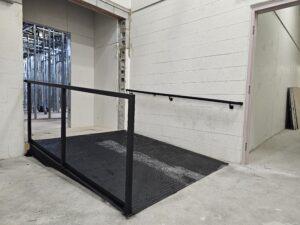
Types of Commercial Metal Stairs Depending on Their Design
Straight with one flight of stairs – the most affordable option, which is often used to reduce the cost of a project;
Straight stair with an intermediate landing – mainly installed in large commercial facilities;
Straight stair with a top platform – convenient for access to industrial equipment;
Quarter turn ladder is a versatile option that is suitable for both residential and commercial places;
Reverse staircase – characterized by turning 180º and most often found in office buildings;
Staircase with alternating steps – it is easy to get to the basement or attic, for which the standard staircase is not suitable;
Cross for overcoming obstacles and access to equipment in production;
Stair towers – have an industrial purpose, with their help, you can get access to tanks and equipment;
Scissor staircases of two flights of stairs – relevant for large office buildings;
Ship ladder stairs – due to their compactness, are used for small buildings, even though the name indicates the use on the ship;
Curved staircase without intermediate platforms – this graceful structure is most often used in the lobby of commercial buildings to add zest to the interior;
Circular ladder – another way to set accents in the design solution of the lobby;
Spiral staircase is the optimal solution for fire escape but can also be used as a design element;
Retractable fire escape stairs are also used to equip fire exits.
Commercial Steel Stairs and Handrails Design Ideas
Given that the stairs we are talking about are in public use, their design must consider the heavy loads and needs of all population segments. So what should be kept in mind when ordering industrial metal stairs or other types of staircases before starting new construction?
1. Such stairs should have enhanced strength and durability, as they will be used by many people, significantly greater than the number of occupants of residential buildings.
2. They must have good capacity, especially if commercial fire escape stairs are meant; after all, when rescuing people, the wider the stairs, the better.
3. The width of the gaps between the handrails should be IBC Compliant – this is to ensure that the head of children who may use the stairs do not fit in between the bars.
4. The surface of the steps must be non-slippery. This is very important for industrial stairs since, at production facilities, employees may be carrying equipment or other loads and will not be able to hold on to the handrail. For exterior fire escape stairs, this is especially important in rainy weather when it is necessary to descend quickly and the surface of the steps is wet.
However, the International and in particular Ontario Building Code strictly regulates the design and construction of industrial and other commercial steel stairs. If you strictly follow the steel fire escape stairs regulations, the construction is sure to be reliable and functional.

Which commercial steel stairs are considered OBC Compliant?
Before talking about fire stairs requirements, you should consider the basic elements of the ladder. Discussing the rules of custom fabrication of structures of this type will not raise questions.
Most occupants of residential buildings, and entrepreneurs as well, pay attention to the parameters of the steps and handrail ladder. In fact, each staircase consists of many more elements:
1. Tread
The surface that you step on as you ascend or descend. Its width is very important – if it is too narrow, people will fall. If the tread is too wide, you must take a big step, which is also uncomfortable.
2. Nosing
The front part of the tread. It is very important to make it as non-slip as possible so that when stepping on the step, your foot will not slip.
3. Riser
This is the part of the step that is vertical under the tread, and, again, its size matters. If the steps are very high, you will have to lift your foot too high when climbing. Low risers are easy to trip on.
4. Stringer
The supporting element of a staircase structure. This inclined part can support the entire ladder and handrail and is located separately on the sides or only in the center.
5. Landing
Flat platforms that are located between flights of stairs or used to turn the staircase. If the area of the building allows, it is better to make landings spacious – it will increase the capacity of the structure.
6. Handrails
The support that people hold on to as they move up and down the staircase. When it comes to commercial steel stairs for public use, the height of all possible users must be taken into account. In other words, installing several railing heights adapted for adults and children is advisable.
Now it’s time to talk about what are the requirements for these elements.
IBC regulations concerning fire escape stairs dimensions and parameters of other commercial stairs
– The minimum width of a staircase must be 44 inches. It is calculated as follows: 0.3 inches per person in buildings not equipped with alarms and sprinklers and 0.2 inches per person in buildings with alarms.
– Metal stairs that will serve a small flow of people (less than 50) may be slightly narrower but not less than 36 inches.
– There should be handrails on both sides of the ladder.
– The distance from the head of the person walking on the ladder to the ceiling must be a minimum of 80 inches.
– The maximum height of a ladder should not exceed 12 feet.
– The riser must not be higher than 7 inches or lower than 4 inches.
– Tread depth must be a minimum of 11 inches.
In addition to the IBC, Canada has another document regulating commercial buildings’ parameters. This is the Canadian Occupational Health and Safety Regulations as well as provincial Building Code and city by-laws. The main points of this document relate to the construction of permanent structures, including metal stairs for public buildings and manufacturing. According to these rules, if the transition between two levels is more than 17.7 inches, the owner of the building is required to install a staircase.
Safety Tips for Metal Fire Escape Stairs
A private type of commercial ladders is emergency exit stairs. They have a very serious function – to help with evacuation in dangerous situations, including fire. Such steel stairs must have an increased strength; after all, the loads on them can be uncontrollable. Also, you can apply non-standard solutions in their construction, including the original form or additional functionality. Let’s consider the main types of exterior fire escape stairs and solutions for placement inside high-rise buildings.

Types of Fire Escape Stairs
1. Drop fire escape
This type is most often used to provide fire safety in factories and other commercial buildings. They are attached directly to the wall of the building and do not take up much space. The peculiarity of their construction should be reliable handrails because such exterior fire escape stairs, as a rule, are located vertically.
2. Counterbalanced fire escape
These structures are used mostly in low buildings; counterbalanced ladders are mobile, so it is quite dangerous to descend from a considerable height with them. They use a system of counterweights so that the lower sliding part drops smoothly.
3. Gooseneck fire escape
This option is just right for high-rise buildings. Such a staircase can consist of as many blocks as the height of the building requires. It is equipped with landings, the number of which is a multiple of the height of the building, and the exit to them is possible from the balconies on each floor.
4. Spiral fire escape stairs
Fire escape spiral stairs are really versatile. They can be used both inside and outside the building, regardless of their height. You can also choose from spiral-shaped fire escapes with or without intermediate platforms.
5. Retractable fire escape stairs
The advantage of such solutions is their compactness. When evacuation is unnecessary, a retractable ladder can take up no more space than a drainpipe. In addition, when it is folded up, the building is inaccessible for intruders. In an emergency, however, such a staircase is easily customized.
Whichever type of fire escape staircases you choose, custom fabrication should ensure that the product meets basic fire safety requirements.
What characteristics should fire escape staircases have?
– fireproof material – that’s why we offer metal fire escape stairs;
– secure fastening to the building;
– obligatory presence of guardrails;
– staircase must reach the ground, and if its lower part is movable, it must extend without any obstacles;
– providing open access to a fire escape, regardless of whether it is inside or outside.
In order to fire blocking stairs and other types of commercial staircases were performed and installed qualitatively, we recommend ordering such services from professionals.

Why Consider Art Metal for Your Commercial Steel Stairs Toronto?
Art Metal is a company that has been working on metal fabrication for 15 years. We give our customers free measurements before making the purchase, and after purchasing the product, we give a lifetime warranty on it.
In addition, by contacting Art Metal, you are guaranteed to get:
– A durable product that can withstand long periods of use and high stress;
– OBC Compliant staircases for maximum safety of your employees and visitors;
– Variety of solutions – we will listen to your idea and create a staircase just for your needs – whether it is fire escape stairs for home, dock stairs, or any other metal constructions;
– Minimum lead time – we will perform all work within the specified time and even faster, and the speed of our work will not affect its quality in any way;
– Saving money – the cost of our products is more than affordable, especially considering their longevity;
– Metal stairs for outside that are easy to install – our specialists have all the necessary tools.
Do you want reliable, beautiful, comfortable steel stairs in your production or office building? Contact the manager of Art Metal for a detailed consultation. We will fulfill all your wishes and do all the work qualitatively and in the shortest possible time.
FAQs About Commercial Steel Stairs
What are the advantages of using steel for commercial stairs?
Steel stairs offer several advantages, including unparalleled durability, strength, and resistance to wear and tear. They are also fire-resistant and can withstand heavy foot traffic, making them ideal for commercial settings. Additionally, steel stairs have a sleek, modern look that can enhance the aesthetics of your building.
Can commercial steel stairs be customized to fit my building’s design?
Yes, commercial steel stairs can be highly customized to fit your specific design requirements. You can choose from various finishes, railing styles, and configurations to complement your building’s architectural style. Custom designs can also include additional safety features to meet building codes and standards.
How do I maintain commercial steel stairs?
Maintaining steel stairs is straightforward. Regular inspections should be conducted to check for signs of rust, wear, or damage. Cleaning with mild detergent and water will keep the stairs looking good, and applying a protective coating can prevent rust and corrosion, enhancing durability over time.
Are commercial steel stairs compliant with safety regulations?
Yes, when properly designed and installed, commercial steel stairs comply with local building codes and safety regulations. Art Metal ensures that all our steel stair installations meet the required standards, including proper tread depth, handrail height, and load-bearing capacity, to provide a safe and secure solution for your commercial properties.



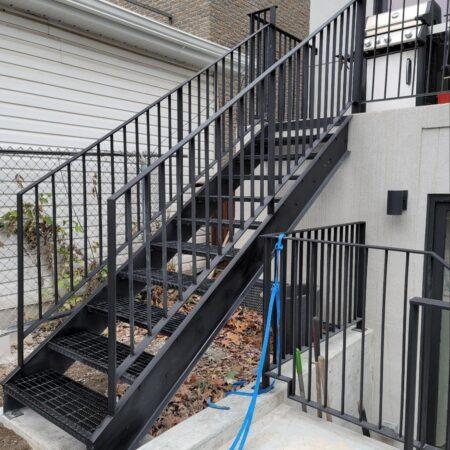




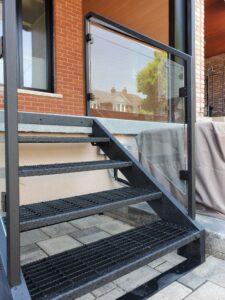


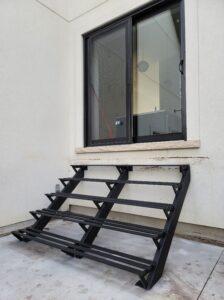

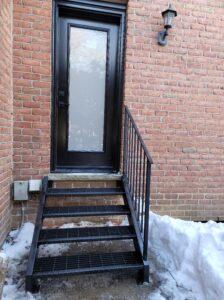
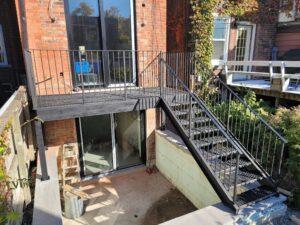











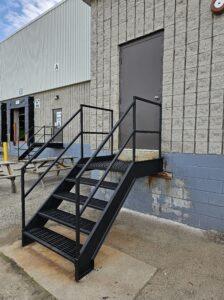




 Chat
Chat 








